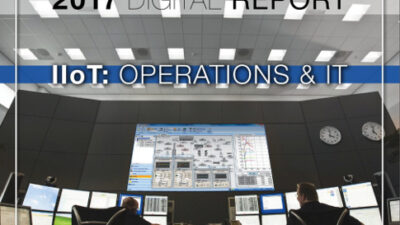Cooper Bussman InVision system detects when a circuit protection device has opened, alerts maintenance personnel which device has operated (phone, text, email), where it is located, part number of the replacement device, and the appropriate level of personal protective equipment to wear to replace or reset the device.
St. Louis, MO – Cooper Bussmann InVision system detects when a circuit protection device has opened, alerts maintenance personnel which device has operated (phone, text, email), where it is located, part number of the replacement device, and the appropriate level of personal protective equipment to wear to replace or reset the device. It uses a proprietary wireless mesh system said to be 99.999% reliable; the company does a site assessment to ensure ease of installation.
First target markets are those in which downtime is particularly expensive : automotive facilities, pulp and paper, food and beverage and steel and aluminum. Kevin Knopf, channel marketing specialist at Cooper Bussmann, says older facilities with a large installed base of fuses may not even quantify costs related to fuses; a goal is to reduce the amount of downtime of the end user.
The InVision system includes wireless sensors, mesh routers, gateway and access to a secure data command center, where the actual component/location database resides. Sensors are battery-powered, wireless, intelligent fuse or circuit monitors, each with a unique ESN number that represents a unique location. Local indication displays a blown fuse or operated device condition. Sensors for fuses clip on the fuse body; sensors for circuit breakers must be wired in. Whether monitoring fuses or breakers, the sensor detects voltage to determine if the protective device has operated. If voltage is present on both sides of the protective device, the device has not operated, and the circuit is intact. If the protective device operates, voltage is present on only one side of the device. The sensor detects this and sends a signal that is picked up by the wireless mesh router, which, in turn, sends the signal to the gateway. The system operates in the 900 MHz band.
The system communicates with the mesh with a one-way transmission from the monitoring sensor, which makes the device more cost-effective. The sensor is not part of the mesh. The gateway resides behind the firewall and monitors the sensors and the mesh. It connects through the Internet to the servers at the command center, which is accessible by the end user. The high-security command center monitors fuse or breaker activity, alerts appropriate personnel when a circuit opens and provides historical data from which trending reports can be generated.
The alarm sent by the command center is typically an audible voice message in the form of a phone call. Alerts can also be made through email, pager or text message. If the person to whom the message is not available or does not acknowledge the alarm, the system’s escalation feature deploys the alert to the next level of support personnel.
www.cooperbussmann.com/7/CooperInVisionDowntimeReductionSystem.html
www.cooperbussmann.com/2/InVisionYourSuccess.html
See wireless feature articles from Control Engineering : www.controleng.com/wireless .
— Edited by Mark T. Hoske, editor in chief
Control Engineering System Integration eNewsletter
Jack Smith, Plant Engineering , contributed.


